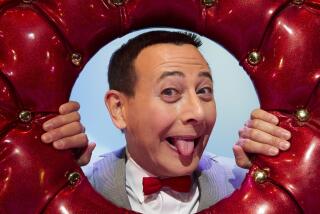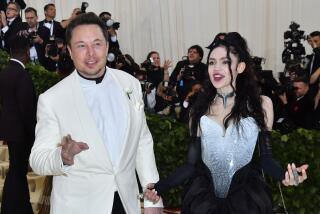Q&A: Mark de Silva talks about his novel ‘Square Wave,’ a paean to process
- Share via
“Nothing is perfect,” Mark de Silva writes in his debut novel, “Square Wave.” “And no process, not at all, is really, truly stable.” In other words, progress is a myth, process our reality. Process — unstable, imperfect — is the true movement of the universe, a vacillation between zenith and nadir rather than a steep line of gradations leading toward eventual perfection.
“Square Wave” (Two Dollar Radio: 376 pp., $17.99 paper) is an experimental paean to process, to our oscillations between extremes, to the revolutions that come and go and the worlds they leave behind in the ping-ponging between the poles that lie at the hinterlands of human experience.
While on patrol as a night watchman, Carl Stagg, the central figure in “Square Wave,” stumbles upon a prostitute who has been a victim of a brutal attack. Stagg and fellow watchman Ravan set out to investigate the assault, which is only the latest in a series of similar crimes. And yet to reduce the plot to this narrative thread would be to miss out on many of the things that make the book so compelling: 17th century Sri Lankan power struggles, weather modification projects, Orwellian dystopic governments, and so on.
All books are inherently about the tension between chaos and order because language itself is, at its very core, an attempt to structure the muddle of existence. Can you talk about the schema of “Square Wave” (if you concede it has one)?
I would say there’s actually quite a lot of structure to the book, only part of it is dramatic structure. In college, I took studio courses in music composition and filmmaking, and I think those have left a mark. Montage, for instance, is an exceptionally potent way of meaning-making. The juxtaposition and sequencing of scenes and themes can throw light on all sorts of curious relations between them. (Think how much Terrence Malick extracts from the technique in “The Tree of Life.”) As for musical structure: what is the literary isomorph of an arpeggio, a chord, or a harmonic progression? I wanted to find out.
The book challenges the reader to find connective tissue rather than force a latticework of meaning onto the text. As you write, “In a scattered world, everything hinged on your capacity to put the pieces together.”
I wanted to cut out the usual editorializing in fiction and simply describe a series of events and ideas, without giving any sense of how I, as the author, understand them, in either a narrative or a moral sense (some of the events depicted are discomfiting). I’ve left it to the reader to decide why things unfold as they do in the book, and also what sort of attitude he ought to take to it. In that way, “Square Wave” is like a Rorschach inkblot. What you see in it will depend on what is on your mind and in your heart.
There are these wonderful discussions in the book, essayistic flourishes on historical, cultural and scientific esoterica such as microtonal music theory and cloud-seeding experiments. Why include them?
I wanted to do two things: follow the stream of consciousness into high-altitude terrain, where our creative discoveries are made; and second, show how, in such territory, consciousness is often not especially stream-like. I’m interested in the texture of obsession, particularly creative obsession: scientific, artistic, philosophical. What is it to be lost to the life of the mind — a casualty of it even? How does it alienate you from the world and from yourself? Equally, though, what are its glories? What does it feel like to float in that rarefied air, in pursuit of beauty and truth? I don’t expect readers to understand all of the subtleties, certainly not on a first read, and perhaps not without reading “out” from the novel, so to speak, and looking into those topics a bit on their own. But that’s not necessary to grasp the shape and feel of these characters’ obsessions. That’s the first thing those passages are meant to accomplish. But they are also there, of course, so I can collage ideas and styles of thinking from many domains, throwing light on the parallels and peculiarities.
In science, a “square wave” oscillates between its extremes, between the fixed minimum and fixed maximum. How do you see the book engaging with ideas of oscillation?
The book repeatedly juxtaposes the noble (the high-flown pursuit of knowledge, art, and social change) and the debased (racism, misogyny, classism, drug abuse, violence) and tries to explore how they are twinned, how one ramifies on the other, and how a full picture of human potential must include both. Also, I am suggesting these are cyclical phenomena, they come in waves, with no lasting progress toward either end of the spectrum. All we get is everything: history, human life, has no tilt. Finally, the book is about various sorts of revolutions, of starting over, of extremes. It’s about wiping away what came before completely — the maximum value falling to the minimum one in one fell swoop. But of course, nothing is really finished, there is always a resurrection, a new order, and frequently these entrench themselves with a confounding swiftness, in life and in the book.
In one passage about art, you write: “That was the problem, the virtue of poetry, of art. It outran you.” Is that what art is and should be? Something that outruns us?
I save the word “art” for works that are enigmatic — irreducibly so. If it doesn’t resist our grasp, if it can be finally known, then it’s something else, possibly something quite valuable, just not art in the sense I mean. In a piece of reportage, say, inscrutability is generally a flaw. (When it isn’t, as in some of Janet Malcolm’s essays, I would tend to call it art and not simply reportage.) You should feel like you’ve fully understood what you’ve just read. But a good novel should leave you second-guessing yourself, in perpetual doubt as to what you’ve experienced. Paintings and films are no different.
I’m curious about your thoughts on the connection between art and violence, especially in relationship to Lewis in the novel.
I think of art as a rejection of things as they stand. It’s a way of saying no, this won’t suffice, the world needs something else — art — in it. Violence is just another way of re-forming what surrounds us into a more satisfactory shape. It too rejects what is, the status quo. So I think the two impulses are not so far apart, and that this is why Lewis can switch from one to the other so readily. They scratch the same itch.
Tyler Malone is a writer and professor of English. He is the founder and editor in chief of the Scofield and a contributing editor for Literary Hub.
ALSO
A look inside the Creation Museum’s cabinet of curiosities
Now Ann Coulter likes Donald Trump so much she’s writing a book, ‘In Trump We Trust’
Don DeLillo’s deep freeze: ‘Zero K’ takes on death, futurists and cryonics
More to Read
Sign up for our Book Club newsletter
Get the latest news, events and more from the Los Angeles Times Book Club, and help us get L.A. reading and talking.
You may occasionally receive promotional content from the Los Angeles Times.






